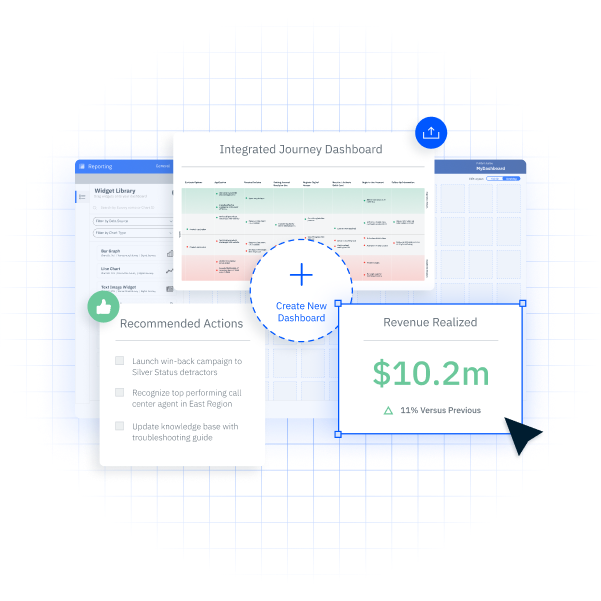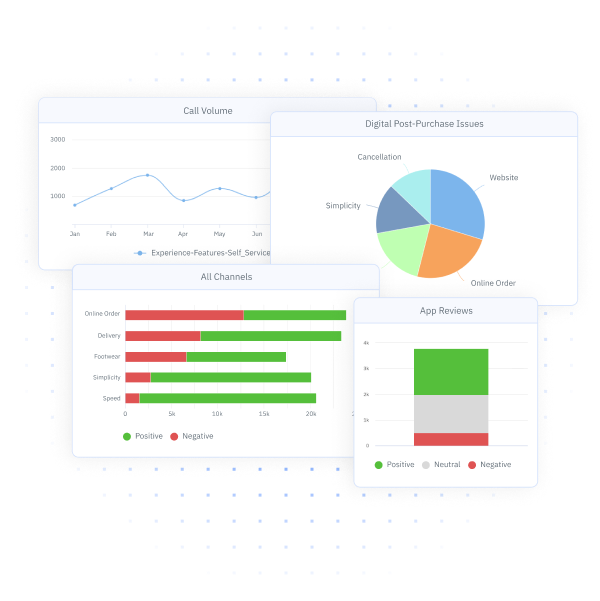Customer Journey: Understanding Every Interaction
The customer journey is the path a consumer takes to become a customer. Improving the customer journey can drive acquisition, retention, and loyalty for your organization.
Did you know that 38% of Millennials and 39% of Gen Z consumers reported that they are most likely to give up solving a problem with a product or service if they cannot find a solution themselves? With younger generations becoming the dominating force in the overall consumer base it is more important than ever to be able to identify their needs and understand how they want to interact with your brand.
As a matter of fact, 56% of customer service leaders said they plan to invest more into their customer journey, which would be a first-time investment for 45% of them. These investments highlight how crucial the customer journey is to a great customer experience and creating lifelong customer relationships.
What Is the Customer Journey?
The customer journey is the process a customer goes through from awareness to purchasing and beyond. To provide an exceptional customer journey, you need to understand your customers—how they interact with your website and what they’re looking for. It’s important to point out that the customer journey is different from the customer experience. Customer journeys are what your customers are doing, while the experience is how they’re feeling. A fully optimized customer journey can help improve your customer experience.
Why Is the Customer Journey Important?
The customer journey is so important because it is the foundation on which customer acquisition and customer loyalty are built. Most consumers express a desire to interact with a brand across multiple channels, but 77% of brands admit they struggle to create a cohesive customer journey across those channels.
If a customer chooses to interact with your organization, it is your responsibility to have a customer journey that gives them a stress-free experience. Without a customer journey, you could have low acquisition rates or increased customer churn rates.
Benefits of Understanding the Customer Journey
When your organization understands the customer journey and can give your customers what they need at the right time, you will realize benefits that will improve your overall business performance. Some of the benefits include:
- Improved Customer Experience: Understanding the customer journey will give your customers a better end-to-end customer experience, which will result in increased customer satisfaction.
- Increased Customer Retention: An understanding of the customer journey allows your business to proactively address issues and provide timely support, which will increase the likelihood of repeat business and long-term customer retention.
- Increased Conversion Rates: By identifying and removing friction points, your business can guide potential customers through the sales process more smoothly.
What are the Principles of Customer Journey?
While there are no set principles of the customer journey, an important step to understanding and designing the customer journey in your organization is to create your own set of customer journey principles that represent an effort to develop long-term customer relationships. Some possible principles include:
Customer Empathy
Customer empathy refers to working to understand the emotional states of customers at each stage of the customer journey. By understanding how customers will feel at certain points, rather than focusing on what action you want them to take, you will create a journey that is easier and less stressful.
Customer Empowerment
Give customers the ability to manage their journey by offering self-service options and transparent processes. Empowered customers feel more in control and satisfied with their experience.
Proactive Engagement
At some point in the customer journey, your customers will connect with you. When they do, be sure to be equipped with the right information in a timely manner to assist them during the customer journey.
These principles are an example of what the principles of customer journey could look like in your organization. The exact principles you choose will depend on your business and the journey you build for your customers. However, they should be customer-focused and put your organization in a position to make the customer experience better.
What Are the Customer Journey Phases?
While the exact steps in the customer journey can vary, these are the six most important parts of the journey for any business:
The Problem
First, customers need to realize they have a problem, a need, or a want that must be solved. Once they recognize a problem, they can begin looking for solutions, which should hopefully lead them to your company.
Awareness
During this stage, the customer is gathering information, researching, and looking for options to solve the problem. Hopefully, with your marketing efforts and channels, the customer will come across your company and become aware of your solution to their problem. They’ll still be weighing options and researching what suits them best, but this stage is a great place to use content to showcase your brand.
Consideration
During this stage, your customer will be considering using your product or service. They may be deciding between you and another option debating pricing options, prioritizing features, and weighing drawbacks. When a customer is considering, brand recognition is crucial. Having a trusted and well-established brand could be what sways a customer toward your product during this stage.
Purchase
The customer decides on your product and makes the purchase. Even once they’ve purchased your product, companies benefit from reaching out to customers and acknowledging the purchase.
Retention
Once a customer has bought a product or service, it doesn’t mean they will return to your company again. A key part of the customer journey is retaining the customer for future purchases. Providing support is important to improve customer retention. You want customers to come back repeatedly and look for your product or service when faced with a problem.
Loyalty
Once your customer comes back to you a few times, they’ll start to develop loyalty to your brand. Loyal customers will almost always come to your company if they can because they trust your products, services, and customer experience. Getting to the loyalty stage takes effort, but loyal customers are the goal of every company.
Understanding the Digital Customer Journey
Businesses such as restaurants, hotels, and retailers have to consider certain aspects of their locations when creating a customer journey such as signage, lighting, walkways, and more. Most other businesses, however, will only ever interact with their customers through digital channels. The digital customer journey is just as important as any customer journey and is crucial to a positive digital experience.
A successful digital customer journey can be difficult to create because you need to make your customers feel understood and wanted, without being able to talk to them in person. This can be done by creating easy self-service options and being readily available through support channels in case they have any questions or concerns.
A Customer Journey Example
To see what the customer journey looks like in action, let’s walk through the journey a manager might take to improve operations.
1. Recognizing the Problem
A hypothetical manager at a finance company recognizes an ongoing issue with managing data for customers. Realizing that this is affecting their efficiency, they start looking for a data management solution.
2. Researching Potential Solutions
The manager starts exploring different data management tools. A friend in the industry recommends a solution they use, while another contact from networking suggests a different option. The manager also conducts internet searches and reads online reviews to find more potential solutions. Meanwhile, targeted ads on Google and social media bring additional products to their attention. Using reviews and priorities, they narrow the list down to two companies.
3. Comparing Final Options
Once they have their two favorites, they use the companies’ software demos and pricing packages to consider each one. They make their selection based on which one works best for their company and is the most affordable.
4. Making the Purchase
After purchasing the data management software, the company immediately acknowledges and thanks the manager for their business. This gesture makes the manager feel valued, reinforcing a positive customer experience.
5. Returning for Future Purchases
A few months later, this same manager is looking for data architecture solutions that will provide security and big data management. They remember their experience with the data management company and start their search on that particular website. When they see they offer software for their needs, they spend less time in the consideration stage and move quickly into purchasing. They also begin recommending the company to other people in the industry when they’re looking for similar products.
The Importance of Improving the Customer Journey
Spending time and resources focusing on the customer journey may seem like a luxury, but the benefits it can have for your organization are a necessity in today’s business environment. Here are some statistics about the importance of focusing on the customer journey:
- 87% of companies use their understanding of the customer journey as a decision-making tool
- 89% of companies can identify gaps in their service by looking at the customer journey
- 91% of companies say an improved customer journey led to increased sales
Overall, this shows that companies that focus on customer journeys can benefit in revenue and profitability. Optimizing the customer journey also helps decision-makers at the company to stay focused on customers. It also helps improve the customer experience and your brand. A well-optimized customer journey makes the purchasing process easier and more enjoyable for the customers, which improves their experience.
Customer Journey Management Best Practices
Successful customer journey management requires every interaction a customer has with your brand to be satisfying while also aligning with business goals. To have an effective customer journey management strategy, you will need to consider these best practices:
1. Map the Customer Journey
Customer journey mapping is a great way to visualize every expected touchpoint a customer will have with your brand. A customer journey map can help you understand the flow of the customer experience.
2. Segment Your Customers
Not every consumer will have the same customer journey, nor will they want to. By segmenting your customers based on demographics, behaviors, preferences, and buying habits, you can create tailored versions of the customer journey to meet the specific needs of these different customers.
3. Utilize Data and Analytics
Customer journey analytics are important to gain insight into how customers interact with your organization. You can start to use customer journey analytics by identifying customer journey touchpoints. Your touchpoints could be ads, your website homepage, a physical storefront, reviews, newsletters, phone calls with sales, or emails.
Once you identify all the touchpoints, you can start to measure how customers interact with them. By keeping track of your customer journey touchpoints, you can optimize them to keep your customers moving through your customer journey seamlessly.

What Is Customer Journey Analytics?
Customer journey analytics is a method of tracking and analyzing every interaction a customer has with your brand across various customer journey touchpoints. By leveraging customer journey analytics, businesses can measure each phase of the customer journey in a detailed and data-driven manner. This includes understanding how customers discover your brand, how they interact with your content, their decision-making process, and the quality of their post-purchase experiences.
This approach provides insights into the effectiveness of your overall customer experience strategy. By evaluating key metrics at every stage, such as conversion rates, engagement levels, and customer satisfaction scores, businesses can pinpoint areas of success and identify potential bottlenecks or pain points.

Customer Journey Metrics to Track
Once you have created your customer journey, you should be able to track where a customer is based on what checkpoints they hit. This may include a free trial, demo appointment, payment, or other points. Since you can track where customers are, you should also be tracking metrics that give you an insight into how effectively your customers move through those stages. Here are some common customer journey metrics you can track:
1. Customer Acquisition Cost
Customer acquisition cost (CAC) measures how much it costs to acquire a new customer, including marketing, sales, and advertising expenses. Tracking CAC can help you evaluate how efficient your customer journey is and help you identify the most cost-effective paths that customers take.
2. Conversion Rate
The conversion rate shows the percentage of potential customers who take a desired action, such as signing up for a newsletter, making a purchase, or completing a demo. By monitoring your conversion rates, you can identify any possible bottlenecks that may be hindering customers from moving forward in the customer journey.
3. Customer Churn Rate
Customer churn rate measures the percentage of customers who stop using your product or service over a given period. This is an important metric to track because it reminds businesses that the customer journey does not end with a purchase. A high churn rate indicates that you may need to improve your customer retention efforts. On the other hand, a low churn rate suggests that your customers value your brand.
4. Customer Satisfaction
Customer Satisfaction (CSAT) is a key metric for evaluating how happy customers are with their overall experience. This metric can be used to track satisfaction levels at various stages of the customer journey or track overall satisfaction.
5. Net Promoter Score
Net Promoter Score (NPS) gauges customer loyalty and their likelihood to recommend your product or service to others. NPS provides insight into whether or not your customer journey is producing strong advocates of your brand that will promote your products or services.
Customer Journey Software
Customer journey software is a powerful tool that enables businesses to map, track, and optimize the interactions customers have with their brands throughout the entire customer journey. Customer journey software platforms provide valuable insights into customer behaviors, preferences, and pain points, which allow companies to create more personalized experiences. Here’s how customer journey software can benefit your business:
1. Visual Journey Mapping
Customer journey software gives you the tools needed to create a customer journey map. This feature helps you visualize the customer journey and understand what metrics can be tracked and where. It can also be a useful sharing tool to get the rest of your CX team on board with the customer journey improvement process.
2. Multi-Channel Tracking
Modern digital customer journeys are often non-linear and span multiple channels such as websites, mobile apps, social media, email, and in-store interactions With customer journey software, you can integrate data from various channels to get a unified view of the customer journey. This helps deliver a cohesive and consistent experience to the customer regardless of where or how they engaged with your business.
3. Behavioral Analytics
Customer journey software can track user behaviors such as click paths, product views, time spent on site, and more. This will help your business identify patterns and behaviors that indicate customer intent.
Improve the Customer Journey with Pearl-Plaza
Improving your customer journey will help your customers learn about your company, products, and services. It will also help you keep your customers moving seamlessly through to the purchasing stage. But ultimately, your customer journey can help you improve your customer experience.
Your customers can enjoy the ease and support your company offers them.
To improve your customers’ journey, you’ll need tools to understand your customers and to utilize your customer journey touchpoints. Pearl-Plaza CX solutions provide feedback and active listening tools to help you understand where to tighten your process and bring more customers to your brand. Schedule a demo today to see how Pearl-Plaza can help you improve the customer journey.
References
Gartner. Top Priorities for Customer Service Leaders in 2024. (https://www.gartner.com/en/customer-service-support/insights/service-leaders-priorities). Accessed 9/3/2024.
Khoros. Must-know customer service statistics 2024. (https://khoros.com/blog/must-know-customer-service-statistics). Accessed 9/4/2024.
Hanover Research. The Power of Customer Journey Mapping. (https://www.hanoverresearch.com/reports-and-briefs/corporate/power-customer-journey-mapping/). Accessed 9/5/2024.






